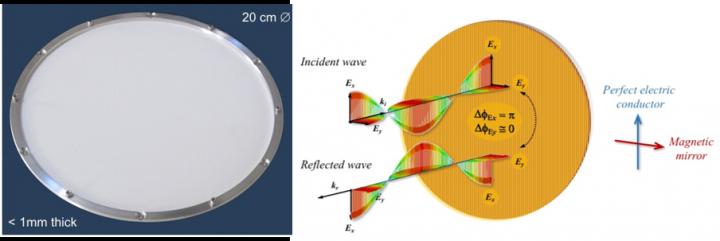Researchers have created a new magnetic mirror-based device that could one day help cosmologists discover new details about ripples in space-time known as gravitational waves, particularly those emitted when the universe was extremely young.
The new work is part of a multi-institutional collaboration funded by the European Space Agency‘s (ESA) Technology Research Program to develop technologies necessary for future experiments such as the proposed Cosmic Origins Explorer satellite mission program. This space mission aims to acquire high precision, full-sky maps of the cosmic microwave background – the relic emission that survived since the Big Bang.
Cosmic microwave background has been the subject of intense investigation since its discovery about 50 years ago. Recent years have seen an increased focus on the polarized components of this microwave background – in particular a component called B-mode, which is thought to hold the key to information about primordial gravitational waves and the physical processes that occurred very early in the history of the universe.
In The Optical Society (OSA) journal Applied Optics, the researchers demonstrated a new type of polarization modulator based on a magnetic mirror. The new device could overcome a major challenge to detecting the B-mode polarization — the ability to modulate microwave polarization across a broad frequency range. Broadband operation is necessary to spectrally discriminate the extremely faint B-mode polarization from the foreground radiation of other astrophysical sources.
“We, like others, have been working for over two decades on the development of technologies that would enable the detection of the B-mode polarization,” said Giampaolo Pisano, Cardiff University, UK, first author of the paper. “This has proven to be a challenging problem because only a tiny part of the overall signal exhibits this polarization.”
Developing the technology
A key component for detecting B-mode radiation is a half-wave plate, a device used to modulate the polarization of electromagnetic radiation. Rotating the half-wave plate causes the polarization of the radiation to also rotate, creating an oscillating pattern that can be distinguished from the constant signal of unpolarized radiation.
Previous implementations of these half wave plates have resulted in inherently narrowband devices due to either the optical properties of available materials or the design used. Operation over a wide range of wavelengths is crucial to distinguishing B-mode polarization originating from the early universe from signals originating from other sources.
“Most of the effort in technology development has been aimed at making optical components that work over larger bandwidths,” said Pisano. “A device that covers a wide frequency range would greatly enhance the performance of complex space-borne instrumentation.”
In the new work, Pisano and his colleagues tried a completely new approach that uses metamaterials – manmade materials engineered with features not found in natural materials – to create a magnetic mirror that they combined with a polarizing wire grid.
“Metamaterials enabled us to invent a material with the characteristics we needed,” said Pisano. “Because the approach we used is new, it allowed us to overcome the frequency range limits that other researchers have faced.”
Their new method takes advantage of the fact that the reflection from an artificial magnetic surface will be out of phase from that reflecting from a perfect electric conductor, or metal. Adding the wire grid to the magnetic mirror allows one polarization to “see” the metal grid, while orthogonally polarized radiation reflects off the magnetic mirror. The resulting device can alter polarization over a large microwave frequency range.
The prototype device demonstrated in the paper operates from about 100 to 400 gigahertz with more than 90 percent efficiency, meaning that less than 10 percent of the signal was lost. The researchers say that with some minor adjustments, they expect to achieve even greater bandwidth and higher efficiency.
Getting ready for space
At 20 centimeters across, the prototype device is a miniaturized version of the one that could ultimately be needed for the Cosmic Origins Explorer satellite. The researchers are now working to develop a half-meter version, with the ultimate goal of developing a final device more than a meter in diameter. Making such a large device with the needed precision will require new facilities and new methods for handling the device during the various manufacturing steps, developments that the researchers say will likely be as difficult as developing the initial concept.
“Now that we’ve demonstrated the concept, we need to perform space qualification tests to demonstrate its ruggedness for a satellite launch,” said Pisano. “We also need to deploy it in ground-based B-mode detection instruments to demonstrate it usability in the field.”


